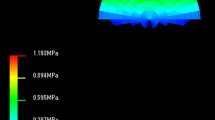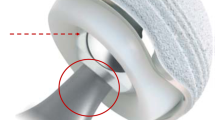Abstract
The oscillation angle (OsA), which is the sum of the impingement angles on the two sides when the prosthetic neck sways from the neutral axis of the acetabular cup to the liner rim, is one of the most important factors that can affect the range of motion of an artificial hip joint. The aim of this study was to determine the influence of total hip component design on the impingement angle. Our findings show that an increase in cup depth of the liner restricts the motion of the neck and results in a reduced impingement angle, while an increase in chamfer angle increases the impingement angle until it reaches a critical value when a further increase no longer results in an increase in impingement angle. The impingement angle is not only dependent on the head/neck ratio, but also on the head size itself. For most arbitrarily chosen cup depths and chamfer angles, the neck only impacts at one point on the liner. This study proposes a suitable combination of cup depth and chamfer angle and a preferred impact mode, which, if impingement does occur, enables the neck to impinge on the liner rim over a large area. Cup–neck combinations that have an adequate OsA with maximum femoral head coverage are presented.








Similar content being viewed by others
References
Bader R, Scholz R, Steinhauser E, Zimmermann S, Busch R, Mittelmeier W (2004) The influence of head and neck geometry on stability of total hip replacement—a mechanical test study. Acta Orthop Scand 75(4):415–421
Bader R, Steinhauser E, Zimmermann S, Mittelmeier W, Scholz R, Busch R (2004) Differences between the wear couples metal-on-polyethylene and ceramic-on-ceramic in the stability against dislocation of total hip replacement. J Mater Sci Mater Med 15(6):711–718
Barrack RL, Thornberry RL, Ries MD, Lavernia C, Tozakoglou E (2001) The effect of component design on range of motion to impingement in total hip arthroplasty. Instr Course Lect 50:275–280
Barrack RL (2003) Dislocation after total hip arthroplasty: implant design and orientation. J Am Acad Orthop Surg 11(2):89–99
Besong A, Jin ZM, Fisher J (2000) Analysis of micro-separation and contact mechanics between the femoral head and the acetabular cup in artificial hip joint replacements. In: 47th annual meeting of the orthopaedic research society, p 1051
Brien WB, Salvati EA, Wright TM, Burstein AH (1993) Dislocation following THA: comparison of two acetabular component designs. Orthopedics 16(8):869–872
Burroughs BR, Hallstrom B, Golladay GJ, Hoeffel D, Harris WH (2005) Range of motion and stability in total hip arthroplasty with 28-, 32-, 38-, and 44-mm femoral head sizes. J Arthroplast 20(1):11–19
Clarke IC, Manley MT (2008) How do alternative bearing surfaces influence wear behavior. J Am Acad Orthop Surg 16(S1):S86–S93
Cobb TK, Morrey BF, Ilstrup DM (1996) The elevated-rim acetabular liner in total hip arthroplasty: relationship to postoperative dislocation. J Bone Joint Surg Am 78(1):80–86
Cobb TK, Morrey BF, Ilstrup DM (1997) Effect of the elevated-rim acetabular liner on loosening after total hip arthroplasty. J Bone Jt Surg Am 79(9):1361–1364
D’Lima DD, Urquhart AG, Buehler KO, Walker RH, Colwell CWJ (2000) The effect of the orientation of the acetabular and femoral components on the range of motion of the hip at different head–neck ratios. J Bone Jt Surg Am 82(3):315–321
Girarda J, Krantza N, Bocqueta D, Wavreillea G, Migaud H (2012) Femoral head to neck offset after hip resurfacing is critical for range of motion. Clin Biomech 27(2):165–169
Gondi G, Roberson JR, Ganey TM, Shahriari A, Hutton WG (1997) Impingement after total hip arthroplasty related to prosthetic component selection and range of motion. J South Orthop Assoc 6(4):266–272
Kessler O, Patil S, Wirth S, Mayr E, Colwell CWJ, D’Lima DD (2008) Bony impingement affects range of motion after total hip arthroplasty: a subject-specific approach. J Orthop Res 26(4):443–452
Kluess D, Martin H, Mittelmeier W, Schmitz K-P, Bader R (2007) Influence of femoral head size on impingement, dislocation and stress distribution in total hip replacement. Med Eng Phys 29:465–471
Ko BH, Yoon YS (2008) Optimal orientation of implanted components in total hip arthroplasty with polyethylene on metal articulation. Clin Biomech 23(8):996–1003
Lin HC, Luo TL, Chen JH (2012) Wear analysis of chamfered elongated acetabular cup liners. Med Biol Eng Comput 50(3):253–260
Malik A, Maheshwari A, Dorr LD (2007) Impingement with total hip replacement. J Bone Joint Surg Am 89:1832–1842
Malviya A, Lingard EA, Malik A, Bowman R, Holland JP (2010) Hip flexion after Birmingham hip resurfacing role of cup anteversion, anterior femoral head-neck offset, and head-neck ratio. J Arthroplast 25(3):387–391
Matsushita A, Nakashima Y, Jingushi S, Yamamoto T, Kuraoka A, Iwamoto Y (2009) Effects of the femoral offset and the head size on the safe range of motion in total hip arthroplasty. J Arthroplast 24(4):646–651
Scifert CF, Brown TD, Pedersen DR, Callaghan JJ (1998) A finite element analysis of factors influencing total hip dislocation. Clin Orthop Rel Res 355:152–162
Soong M, Rubash HE, Macaulay W (2004) Dislocation after total hip arthroplasty. J Am Acad Orthop Surg 12(5):314–321
Usrey MM, Noble PC, Rudner LJ, Conditt MA, Birman MV, Santore RF, Mathis KB (2006) Does neck/liner impingement increase wear of ultrahigh-molecular-weight polyethylene liners? J Arthroplast 21(6):S65–S71
Valle GDV, Ruzo PS, Li S, Pellicci P, Sculco TP, Salvati EA (2001) Dislodgment of polyethylene liners in first and second-generation Harris-Galante acetabular components. J Bone Jt Surg Am 83(4):553–559
Vendittoli PA, Ganapathi M, Nuño N, Plamondon D, Lavigne M (2007) Factors affecting hip range of motion in surface replacement arthroplasty. Clin Biomech 22(9):1004–1012
Widmer KH (2003) Comment on “A mathematical formula to calculate the theoretical range of motion for total hip arthroplasty”. J Biomech 36(4):615
Williams D, Royle M, Norton M (2009) Metal-on-metal hip resurfacing: the effect of cup position and component size on range of motion to impingement. J Arthroplast 24(1):144–151
Williams S, Butterfield M, Stewart T, Ingham E, Stone M, Fisher J (2003) Wear and deformation of ceramic-on-polyethylene total hip replacements with joint laxity and swing phase microseparation. Proc Inst Mech Eng Part H 217(2):147–153
Wu JSS, Hsu SL, Chen JH (2010) Evaluating the accuracy of wear formulae for acetabular cup liners. Med Biol Eng Comput 48(2):157–165
Wu JSS, Hsu SL, Chen JH (2010) Wear patterns of, and wear volume formulae for, cylindrically elongated acetabular cup liners. Med Biol Eng Comput 48(7):691–701
Wu JSS, Hsu SL, Chen JH (2010) Wear patterns of, and wear volume formulae for, hemispherical acetabular cup liners. Wear 268:481–487
Yamaguchi M, Bauer TW, Hashimoto Y (1997) Three-dimensional analysis of multiple wear vectors in retrieved acetabular cups. J Bone Jt Surg Am 79(10):1539–1544
Yoshimine F, Ginbayashi K (2002) A mathematical formula to calculate the theoretical range of motion for total hip replacement. J Biomech 35(7):989–993
Yoshimine F (2005) The influence of the oscillation angle and the neck anteversion of the prosthesis on the cup safe-zone that fulfills the criteria for range of motion in total hip replacements. The required oscillation angle for an acceptable cup safe-zone. J Biomech 38(1):125–132
Yoshimine F (2006) The safe-zones for combined cup and neck anteversions that fulfill the essential range of motion and their optimum combination in total hip replacements. J Biomech 39(7):1315–1323
Acknowledgments
The authors would like to thank the National Science Council of the Republic of China, Taiwan, for financially supporting this research under Contract No. NSC100-2221-E-040-006-MY2.
Author information
Authors and Affiliations
Corresponding author
Rights and permissions
About this article
Cite this article
Lin, HC., Chi, WM., Ho, YJ. et al. Effects of design parameters of total hip components on the impingement angle and determination of the preferred liner skirt shape with an adequate oscillation angle. Med Biol Eng Comput 51, 397–404 (2013). https://doi.org/10.1007/s11517-012-1008-3
Received:
Accepted:
Published:
Issue Date:
DOI: https://doi.org/10.1007/s11517-012-1008-3




